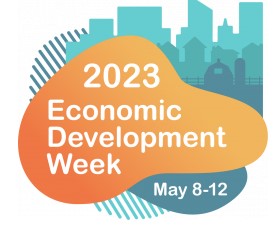
Economic Development Week is May 8-12, 2023. Check out our FAQ to learn more about economic development and how it relates to you!
Economic Development is the creation of wealth from which community benefits are realized. (CALED)
Economic growth creates wealth as new dollars from outside the community or state are generated by economic base businesses. Economic development programs attract these businesses, creating more jobs and lifting incomes in the community.
Businesses or industry sectors that export their products or services are economic base because they bring new jobs and new revenue to other businesses.
New jobs mean increased income tax revenue and new spending equates to increased sales tax revenue. Tax revenue pays for police, fire, schools, infrastructure, community development and services, museums, and more.
These companies can locate anywhere and the long-term economic benefits each provides creates the competition for these benefits.
More than 40 of the 50 states provide some type of incentive(s) to compete for new economic base companies.
The growth of economic base companies creates sustained economic growth for the region and the state.
The State of New Mexico has two primary incentives to offer economic base businesses (both existing and new) that have allowed us to compete successfully for companies like Ball Corporation, WTEC Energy, Facebook, Jabil, Netflix, NBCUniversal, and a new Intel facility.
The first is the Local Economic Development Act (LEDA) which allows the state to invest in permanent infrastructure that results in new jobs and new investment from an economic development project. These investments are made only when the community realizes the benefits of sustained economic growth.
The second incentive is the Job Training Incentive Program (JTIP), which celebrated its 50th anniversary in 2022. JTIP has been recognized as one of the top economic development incentive programs nationally. JTIP invests in New Mexico workers, which also benefits the growing company. Employees get new jobs and skills, and businesses benefit both by partial reimbursement of the employee’s wages during training and gaining a more skilled workforce.
The research and technology development at our national laboratories and universities is beneficial to businesses and accessible either through direct assistance from lab scientists or by technology transfer.
New Mexico has a workforce with a good reputation nationally. We have a high percentage of scientists and engineers, also due to the labs. Additionally, tuition-free college increase the level of education in our workforce, which attracts businesses that pay high wages.
The largest deterrent is the lack of available industrial buildings and other infrastructure. The timeframe for many economic development projects does not allow for construction and the build-out of basic infrastructure such as electricity and water to the site. Therefore, if the state has no buildings or shovel-ready sites available, the project will likely locate elsewhere.
Gov. Lujan Grisham has chosen nine target economic base industries in New Mexico based on the state’s existing foothold in these industries and opportunities for growth: aerospace, biosciences, cybersecurity, film and television, global trade, intelligent manufacturing, outdoor recreation, sustainable energy, and value-added agriculture. These target industries were chosen because they are a good fit for the state’s cultures, environment, history, workforce, and future, and they also offer opportunities for significant growth in income levels.
Sectors such as construction and mining are considered economic base, but their location factors are different. Extractive industries locate where the product is found and grow with product demand. Construction sector growth is driven by market factors and economic conditions. Non-economic base companies, such as retail shops, typically recirculate dollars within the economy rather than bringing in new dollars and tend to offer lower wages and fewer indirect and induced jobs.
Data is critical in determining the level of incentives the state will provide for a project. For a LEDA investment, the 10-year economic impact of the project (company) to the locale and the state is estimated using data that includes jobs, wages, private investment, and company spending.
In the case of JTIP, the amount of support provided to the company is determined by the number of jobs, wages and benefits paid, location, and the skill level of the position.
Data on jobs, wages, spending, and tax revenue is collected and reported for New Mexico and all 33 counties quarterly. This data tells us the economic health of each locale in real-time.
Monitoring the health of the economy tells us if our programs and services are effective.
Read our latest opinion piece about Economic Development week – May 8-12, 2023:
https://www.abqjournal.com/2596688/economic-development-week.html
May 10, 2023 – EDD Deputy Secretary Jon Clark and AREA President and CEO Danielle Casey discuss the importance of Economic Development on KRQE News